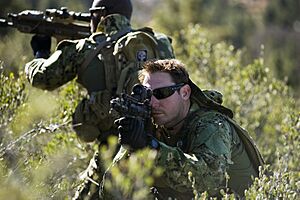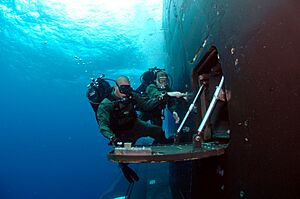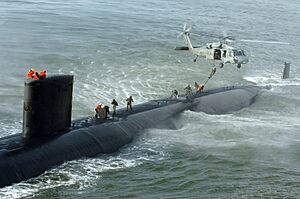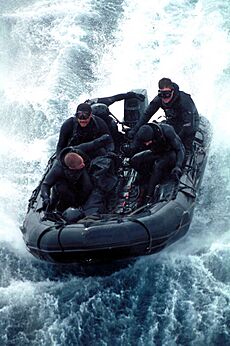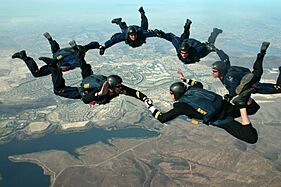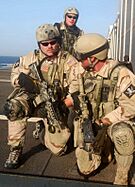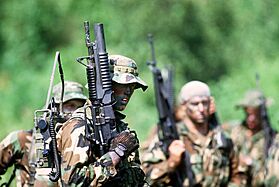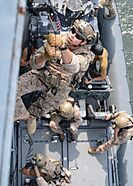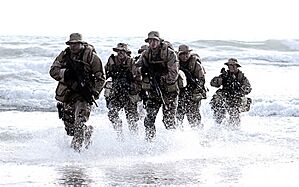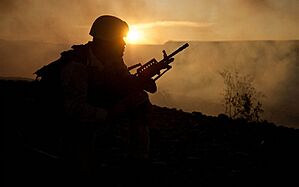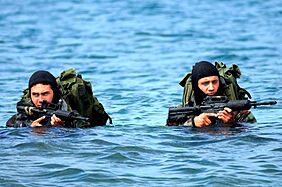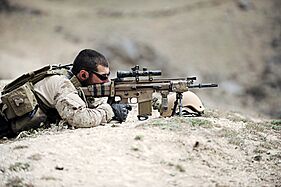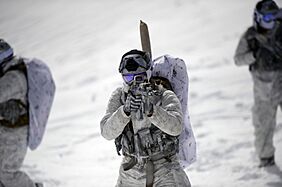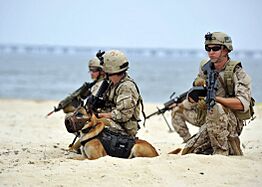United States Navy SEALs facts for kids
Quick facts for kids United States Navy SEALs |
|
|---|---|

Special Warfare insignia known as the "SEAL Trident"
|
|
| Active | January 1, 1962 – present (63 years, 8 months) |
| Country | |
| Branch | |
| Type | Special operations force |
| Role |
|
| Part of |
|
| Garrison/HQ | Naval Amphibious Base Coronado Joint Expeditionary Base–Little Creek |
| Nickname(s) | "Frogmen", "The Teams", "Team Guys", "The Men with Green Faces" |
| Motto(s) | "The Only Easy Day Was Yesterday" "It Pays To Be A Winner". "Never Out Of The Fight". |
| Engagements |
|
The United States Navy Sea, Air, and Land (SEAL) Teams, known as Navy SEALs, are the main special operations force of the United States Navy. They are part of the United States Naval Special Warfare Command. SEALs carry out small, special missions in many different places. These include oceans, jungles, cities, cold arctic areas, mountains, and deserts. Their main jobs often involve capturing or stopping important targets. They also gather secret information behind enemy lines. SEALs are chosen very carefully and get a lot of training. They are experts in special warfare, direct action, and scouting. They also do things like sabotage, demolition, and helping friendly armies. All active SEALs are members of the U.S. Navy.
Even though the U.S. Navy SEALs officially started in 1962, their roots go back to World War II. During that war, the U.S. military needed a way to secretly explore beaches where troops would land. They also needed to check coastal defenses. Because of this, the Army, Marine Corps, and Navy created the Amphibious Scout and Raider School in 1942. This school was set up in Fort Pierce, Florida. The Scouts and Raiders group was formed in September 1942. This was just nine months after the attack on Pearl Harbor. They came from a joint Army-Marine-Navy unit called the Observer Group.
How SEALs are chosen and trained
To even be considered for Basic Underwater Demolition/SEAL (BUD/S) training, a person must pass many tough mental and physical tests. These tests include a medical check, the ASVAB (a military aptitude test), and a physical screening test (PST). The PST includes:
- A 500-yard swim in 12 minutes and 30 seconds.
- 50 push-ups in 2 minutes.
- 50 sit-ups in 2 minutes.
- 10 pull-ups in 2 minutes.
- A 1.5-mile run in 10 minutes and 30 seconds.
If a candidate passes these tests, they might get a SEAL contract. This allows them to start the training. SEAL training is extremely hard. About 80 percent of candidates do not finish.

The average candidate spends over a year in formal training. After this, they earn the title of Special Warfare Operator. This means they are officially a Navy SEAL.
Here are the main steps in Navy SEAL training:
- 8 weeks of Naval Recruit Training.
- 8 weeks of Naval Special Warfare Prep School (Pre-BUD/S).
- 3 weeks of BUD/S Orientation.
- 24 weeks of Basic Underwater Demolition/SEAL Training (BUD/S).
- 3 weeks of Army Airborne School (learning to parachute).
- 26 weeks of SEAL Qualification Training (SQT).
After finishing SQT, trainees get the U.S. Navy SEAL Trident. This is a special badge that shows they are Navy SEALs. They are then sent to a SEAL Team or SEAL Delivery Vehicle (SDV) Team. Before they can go on missions, they get another 18 months of training. This includes:
- 6 months of Professional Development (learning special skills).
- 6 months of Unit Level Training (team training for air, land, and water missions).
- 6 months of Squadron Integration Training (working with their specific team).
Overall, it can take more than two and a half years to fully train a Navy SEAL for their first mission.
Women in the SEALs
Before December 2015, women were not allowed to become Navy SEALs. However, this rule has changed. In August 2015, the Navy announced plans to open SEAL teams to women. This would happen if they could pass the very tough training. The Chief of Naval Operations at the time, Admiral Jon Greenert, agreed. He said that if women could pass the six-month Basic Underwater Demolition/SEAL (BUD/S) training, they should be allowed to serve.
On December 3, 2015, it was announced that all military jobs in the U.S. were open to everyone. This meant women could become U.S. Navy SEALs. Since 2016, 18 women have tried to pass SEAL or Special Warfare Combatant-craft Crewmen (SWCC) training. In 2017, one woman aiming to be the first female Navy SEAL officer left training after about a week. In 2019, the Navy said that an unnamed female officer was the first to complete the SEAL Officer Assessment and Selection program (SOAS). She chose a different Navy job instead of starting BUD/S.
As of 2015, there are about 8,195 SEALs and SWCCs in the Naval Special Warfare Command. Including civilian support staff, the total is about 10,166 people.
The Naval Special Warfare Command is set up in different groups:
- Naval Special Warfare Group 1 – located at Naval Amphibious Base Coronado in California. This group includes SEAL Team 1, 3, 5, and 7.
- Naval Special Warfare Group 2 – located at Joint Expeditionary Base–Little Creek in Virginia. This group includes SEAL Team 2, 4, 8, and 10.
- Naval Special Warfare Group 4 – also at Joint Expeditionary Base Little Creek in Virginia. This group focuses on special boat teams.
- Naval Special Warfare Group 8 – also at Joint Expeditionary Base Little Creek in Virginia. This group includes SEAL Delivery Vehicle Teams and Special Reconnaissance Teams.
- Naval Special Warfare Group 11 – located at Naval Amphibious Base Coronado in California. This group includes SEAL Team 17 and 18, which are reserve teams.
- Naval Special Warfare Development Group (also known as DEVGRU or SEAL Team 6) – located in Virginia Beach, Virginia. This is a highly specialized unit.
SEAL Teams
The first SEAL Teams were divided between the West Coast (Team One) and East Coast (Team Two). Today, SEAL Teams are organized into two main groups: Naval Special Warfare Group One (West Coast) and Naval Special Warfare Group Two (East Coast). Both are under the Naval Special Warfare Command in California. As of 2006, there are eight active Navy SEAL Teams: 1, 2, 3, 4, 5, 7, 8, and 10. SEAL Team 7 and 10 were formed in 2002. Two reserve support teams became SEAL teams in 2008.
SEAL Teams can be sent anywhere in the world. They often work as part of larger special operations forces. Each SEAL Team is led by a Navy Commander. It has eight operational SEAL platoons and a headquarters. A "Team" is divided into two to four "task units" of about 40 men. Each task unit has a leader and support staff. Under them are two to four SEAL platoons, each with 16 men (two officers and 14 enlisted SEALs).
A 16-man platoon can be split into smaller groups for missions. These can be two eight-man squads, four four-man fire teams, or eight two-man sniper/scouting teams. A typical SEAL platoon has an officer in charge, a platoon chief, and two squads. The other members are operators with special skills. These skills include handling weapons, communications, diving, and medical aid.
SEALs have many core skills, such as:
- Sniper: Expert marksman.
- Breacher: Can open locked doors or obstacles.
- Communicator: Manages radio and data links.
- Corpsman: Provides medical care.
- Lead Diver/Navigator: Guides underwater missions.
- Explosive Ordnance Disposal: Handles bombs and explosives.
Naval Amphibious Base Little Creek in Virginia Beach, Virginia, is home to SEAL Teams 2, 4, 8, 10, and 18. Naval Amphibious Base Coronado in Coronado, California, is home to SEAL Teams 1, 3, 5, 7, and 17. There are also two SEAL Delivery Vehicle (SDV) units. SDVT-1 is in Pearl Harbor, Hawaii, and SDVT-2 is in Little Creek, Virginia. SDV Teams are SEAL teams that can also deliver equipment underwater. An SDV platoon has 12–15 SEALs.
| Insignia | Team | Deployment Area | Number of Platoons | Headquarters | Notes |
|---|---|---|---|---|---|
 |
SEAL Team 1 | Worldwide | 8 platoons | Coronado, California | |
 |
SEAL Team 2 | Worldwide | 8 platoons | Virginia Beach, Virginia | |
 |
SEAL Team 3 | Middle East | 8 platoons | Coronado, California | |
 |
SEAL Team 4 | Worldwide | 8 platoons | Virginia Beach, Virginia | |
 |
SEAL Team 5 | Worldwide | 8 platoons | Coronado, California | |
 |
Naval Special Warfare Development Group (SEAL Team 6) |
Worldwide | Classified | Virginia Beach, Virginia | SEAL Team 6 was officially ended in 1987. The Navy then created the Naval Special Warfare Development Group, also called DEVGRU. While DEVGRU gets support from Naval Special Warfare Command, it works under the Joint Special Operations Command. |
 |
SEAL Team 7 | Worldwide | 8 platoons | Coronado, California | |
 |
SEAL Team 8 | Worldwide | 8 platoons | Virginia Beach, Virginia | |
 |
SEAL Team 10 | Middle East | 8 platoons | Virginia Beach, Virginia | |
| SEAL Team 17 | Worldwide Reserve |
2 platoons | Coronado, California | Used to be called Operational Support Team 1. | |
| SEAL Team 18 | Worldwide Reserve |
2 platoons | Virginia Beach, Virginia | Used to be called Operational Support Team 2. | |
 |
SEAL Delivery Vehicle Team 1 | Indian and Pacific Oceans, Middle East | 4 platoons | Pearl Harbor, Hawaii | |
 |
SEAL Delivery Vehicle Team 2 | Atlantic Ocean, Europe and the Americas | 4 platoons | Virginia Beach, Virginia |
Special Warfare Jobs
In 2006, the Special Warfare Operator (SO) and Special Warfare Boat Operator (SB) jobs were created. This means that Navy SEALs (Special Warfare Operators) and SWCCs (Special Warfare Boat Operators) no longer need to keep their original Navy job titles.
Here are the specific job titles for Navy SEALs:
| Navy Job Title | Short Form | Pay Grade | Special Warfare Job Title | Short Form | Rank Badge |
|---|---|---|---|---|---|
| Master chief petty officer | MCPO | E-9 | Master chief special warfare operator | SOCM | |
| Senior chief petty officer | SCPO | E-8 | Senior chief special warfare operator | SOCS | |
| Chief petty officer | CPO | E-7 | Chief special warfare operator | SOC | |
| Petty officer first class | PO1 | E-6 | Special warfare operator, first class | SO1 | |
| Petty officer second class | PO2 | E-5 | Special warfare operator, second class | SO2 | |
| Petty officer third class | PO3 | E-4 | Special warfare operator, third class | SO3 |
The Navy Parachute Team (NPT) helps recruit new members for Naval Special Warfare. They do this by performing parachute demonstrations. The U.S. Navy Parachute Team has fifteen members, all of whom are U.S. Navy SEALs. Each member joins the team for a three-year period. After their time on the team, they go back to their regular SEAL units.
The parachute team started in 1969. Navy SEALs and Frogmen volunteered to perform at air shows on weekends. The team was officially named the U.S. Navy Parachute Team in 1974. Their mission was to show the excellence of the Navy across the United States.
A typical "Leap Frogs" show involves six jumpers. They jump from an aircraft at 6,000 feet. As they freefall, they sometimes use smoke or streamers. Then, they fly their parachutes close together to create formations in the sky. After their performances, the Leap Frogs meet the public. They answer questions about the Navy and the Naval Special Warfare community. They also sign autographs.
SEAL Influence on Other Countries

The U.S. Navy SEALs and their earlier units, the Underwater Demolition Teams, have helped train and form special units in other countries.
- In 1955, the Underwater Demolition Teams helped fund and train the Republic of Korea Naval Special Warfare Flotilla. These are also known as UDT/SEALs.
- In 1956, they helped fund, train, and create the Philippine Navy Underwater Operations Team (UOT). This team was based on the training of U.S. Navy SEALs and UDTs.
- In 1966, U.S. Navy SEALs helped set up Pakistan's Special Service Group. This was done through a program of military education and training.
- U.S. Navy SEALs also provided early training to the Indian Marine Special Force, which later became known as the MARCOS.
Because of their strong reputation, SEALs often do training exchanges with special operations forces from allied countries.
The National Navy UDT-SEAL Museum is in Fort Pierce, Florida. It was founded in 1985 and is a recognized National Museum. The museum works to preserve the history of the Navy SEALs and their earlier groups. The SEAL Museum is located at the original training site for the first Navy frogmen. During World War II, thousands of service members trained there. They became members of Naval Combat Demolition Units and Underwater Demolition Teams. The Museum has rare historical items from the UDT's beginning to today. These include weapons, vehicles, and equipment. One recent addition is the Maersk Alabama lifeboat. Somali pirates held Captain Richard Phillips hostage on this boat.
The Navy SEAL Museum states that 298 UDT and SEALs have died in action or during training accidents as of March 2018:
- World War II and the Korean War (1941–1953): 96 people.
- Vietnam and the Cold War (1954–1989): 104 people.
- Desert Storm and the war on terror (1990 – March 2018): 98 people.
Images for kids
-
A SEAL "Leap Frogs" parachute team high above San Diego
-
SEALs during a VBSS training in support of Operation Iraqi Freedom
-
A SEAL takes up a defensive position in a village in northern Zabul province, Afghanistan, 10 April 2010.
See also
 In Spanish: SEAL para niños
In Spanish: SEAL para niños


